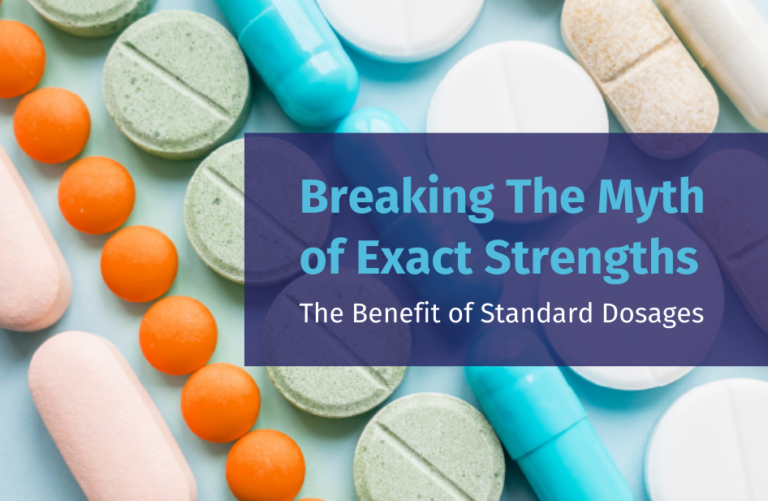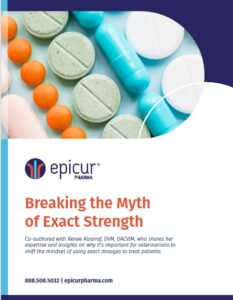When ordering a patient’s medication, the traditional mindset in veterinary medicine is to be as exact as possible. This results in requests for precise dosages such as 1.22 milligrams or other 0.1 levels. Because patient care is the top priority, it’s common to trust that exact strengths are the best course of treatment.
However, the more closely we look at what it takes to compound an exact strength, the clearer it becomes standard dosages are more beneficial to both patients and veterinary practices. Exact strengths are compounded by a technician in capsules or tablets at traditional 503A pharmacies. This leaves the specification of the drug strength up to the experience of that technician, who isn’t required to run potency testing to ensure specification.
Luckily, there is another option. 503B outsourcing facilities follow cGMP processes to manufacture drugs in standard dosages and bulk quantities for office use. These FDA-regulated manufacturing processes require 503B manufactured drugs to go through extensive potency testing to ensure the drug is within +/- 10% of the strength on the label. The potency deviation from a manufactured drug is often significantly less than patient-specific formulations being hand-made by a technician.

Renee Alsarraf, DVM, DACVIM has made 503B standard strengths her standard of care for patients, seeing benefits to their treatment and her practices. She shares her insights on why veterinary medicine needs to break the myth that exact strengths are what patients need.
Get Dr. Alsarraf’s full breakdown of the potency myth in our new download – see a comparison of potency and testing standards in different pharmacy providers and read the quick takeaways on how to change the standard in your practice.
Q. Why isn’t the guaranteed +/- 10% window of standard strengths a more common choice among veterinarians?
I think there can be a fear attached to not being exact as a healthcare provider. 503B pharmacies are still a newer option for veterinarians, and I think when something is less familiar there is fearfulness. No healthcare provider, in human or animal medicine, wants to make a mistake.
That’s why it’s so important to help veterinarians change their mindset. They need to know that it’s not only okay to use standard formulations, but also medically 100% acceptable. Because there is no way to ensure that each tablet or capsule from a 503A pharmacy has exactly 1.62 milligrams of drug in it, 503Bs provide very set standards for easier formulations, such as 1.5 mg, 2.5 mg, 3 mg, and so on.
Those standard strengths make it a whole lot easier and safer to treat patients. But ultimately, I think the particular compounding pharmacy that you choose is much more important than deciding between a 1.5 milligram tablet and a 1.6 milligram tablet. The pharmacy partner you choose determines product quality – in terms of stability, shelf life, sterility, and the basic compounds that are used to make the tablet or capsule. Good quality ingredients make a big difference. The quality of the product ingredients can impact the overall therapy and the ability of that animal to break it down and absorb it.
Do you know what quality control measures your pharmacy partner has in place? And do they stand by those measures? It can’t be all talk; they need to stand by it because, for a lot of these medications, we’re not just talking about antibiotics. We’re talking about serious chemotherapy drugs, heart medications, and eyedrops that treat very sensitive and fragile organs.
Purity and potency become even more crucial for veterinary specialties. So, for me, it comes down to the quality of that pharmacy and I think that should always be the case in veterinary medicine.
Q. Is part of that quality the standardized testing that 503B manufacturing facilities are required to conduct for potency?
Absolutely. I don’t think a lot of veterinary professionals realize how robust the testing is on these products and the detailed process for a
DID YOU KNOW….
503As are not required to test and it’s extremely costly to do so for one-off prescriptions in exact, odd strengths.
For this reason, the potency range of 503A compounded drugs is all over the map. Veterinarians cannot be sure their patient is getting what they prescribe. 503Bs only offer a set list of “standard” strengths but they are guaranteed to fall within +/- 10% of the labeled strength.
While many pharmacies claim to have high quality and say they ‘test’ their medications, this may not be the case. Be confident in the pharmacy partner you choose. Don’t be afraid to ask hard questions and ask for proof of testing!
a particular drug to go from initial prescription at conception to getting mailed out to that owner—all the checks and balances that a 503B pharmacy does to ensure the quality of the medication.
With Epicur in particular, I had the chance to tour the facility and I was blown away by the quality of your product, how it is safely stored, how the initial ingredients or compounds are tested, and how they’re tested again once they become that drug.
It’s incredible to know that you validate every batch of drugs that goes out. You’ve done tests on them to know that they are what they say they are, that they are safe, that they are the milligrams on the label, and that the patient and the veterinary provider are getting the highest quality product. As a veterinarian, I can rest assured that my patients are getting the best possible care.
Q. How do standard strengths simplify patient and pet owner treatment compliance?
As a Veterinary Oncologist, I remember times when we couldn’t have a compounding pharmacy make certain dosages or strengths so we would have to piecemeal dosages. This meant explaining to a pet parent when to give specific tablets or how to open a capsule to only sprinkle half of the medicine on the food. It’s crazy that we accepted that, but it was the best we had.
Now we’re so fortunate because we have reliable, safe pharmacies that can provide correct dosages and administration has gotten easier. If it’s easier to administer, both in the office and at home, then there’s better compliance, and everyone benefits.
503B manufacturing has also increased safety in drug handling. Epicur’s chemotherapy tablets are a great example of this. The packaging is much safer for the veterinary staff to handle and makes dispensing the take-home dose to the pet owner easier. They eliminate the risk of chemo spills, and the owner doesn’t have to count the tablets and try to remember if they already gave a dose, which again promotes better treatment compliance.
Q. With the growth of online services, how can veterinarians help a pet owner know that the ease of ordering may put quality at risk?
The source of the medication makes such a big difference. What’s scary is many of these places are not regulated, certainly not regulated overseas. They do not have the same stringent requirements as an FDA-registered or regulated 503B facility.
Telling pet owners ahead of time is important. They need to know that if their pet isn’t doing as well as it should be or as expected, they need to consider the quality of the medication. Specifically for oncology, if the pet doesn’t go into remission or the remissions don’t last as long, or it’s causing more side effects or problems with the white blood cell count, it’s going to be hard to know if this is just what would have happened or if it’s because of the medication they were given. The quality of medication makes a big difference.




